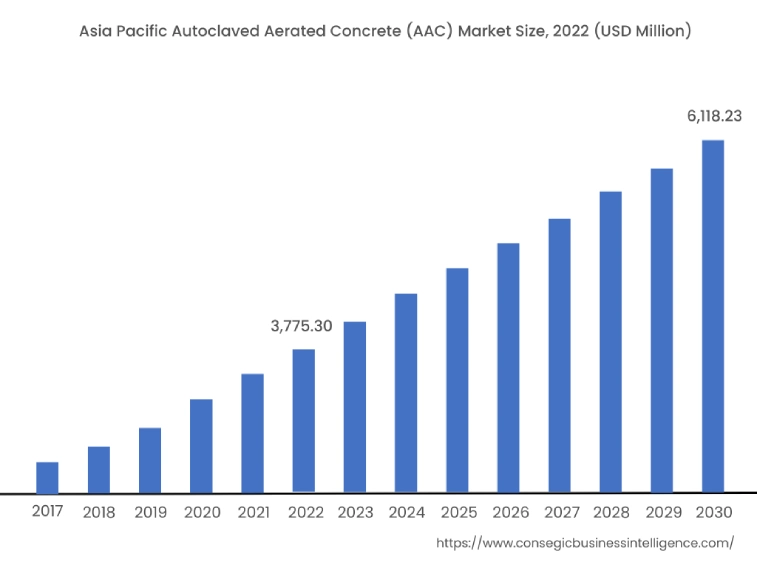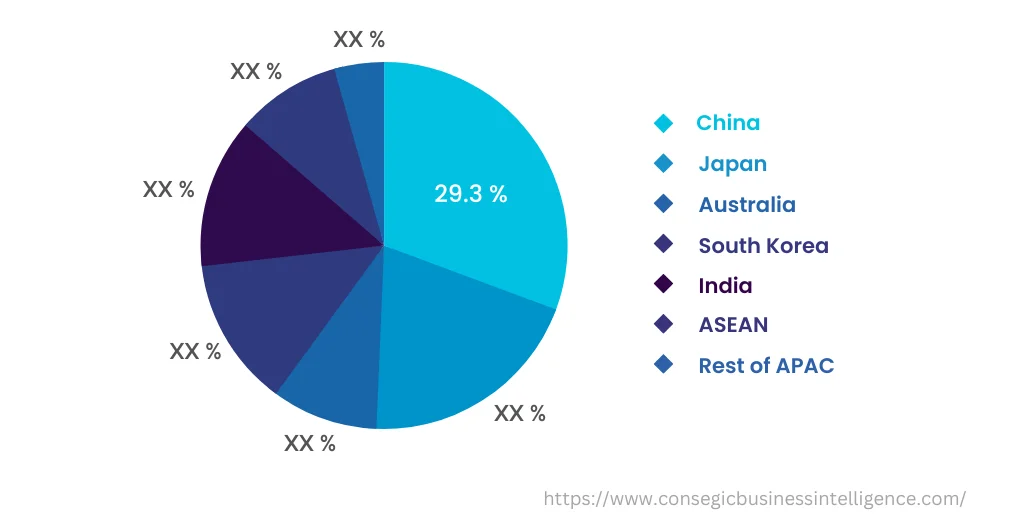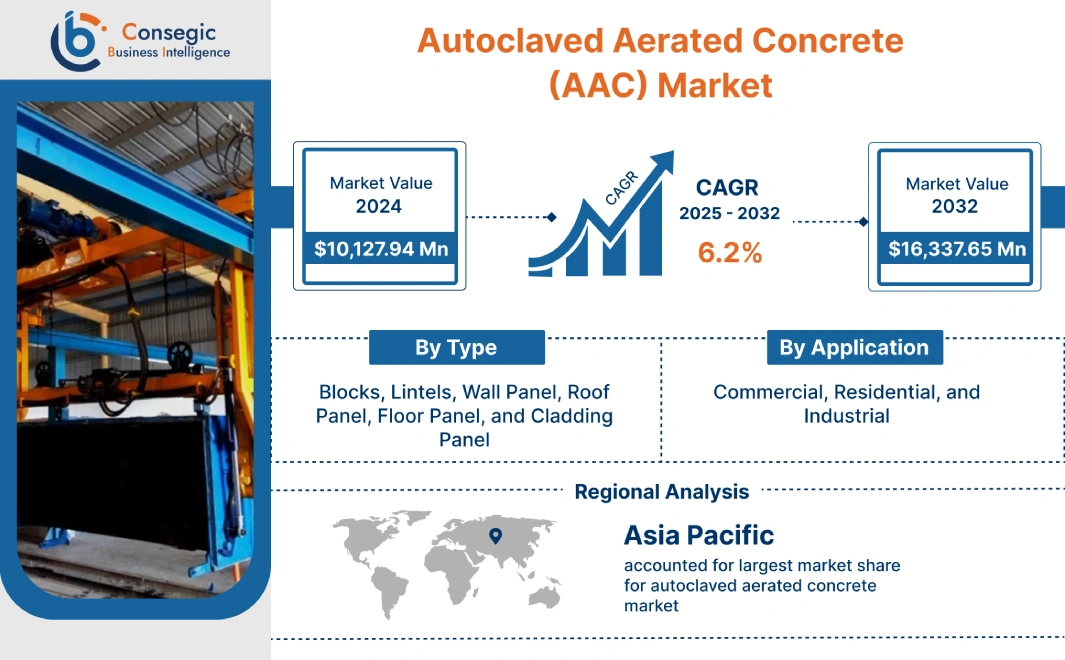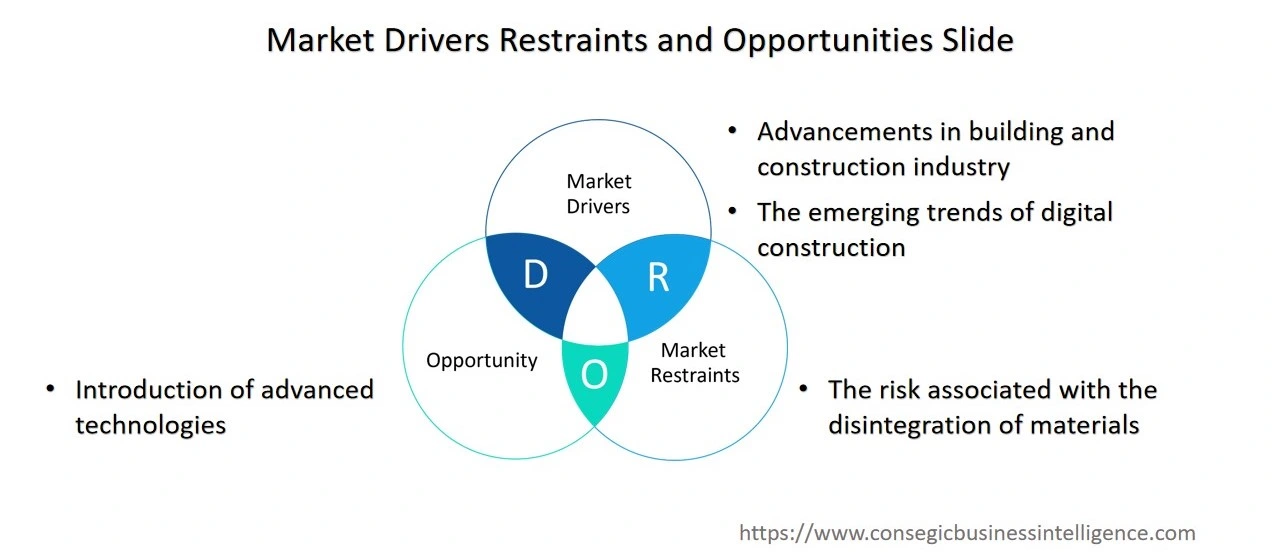- Summary
- Table Of Content
- Methodology
Global Autoclaved Aerated Concrete (AAC) Market Size :
Autoclaved Aerated Concrete (AAC) Market size is estimated to reach over USD 16,337.65 Million by 2032 from a value of USD 10,127.94 Million in 2024 and is projected to grow by USD 10,571.36 Million in 2025, growing at a CAGR of 6.20% from 2025 to 2032.
Autoclaved Aerated Concrete (AAC) Market Scope & Overview:
Autoclaved Aerated Concrete (AAC) is referred as precast, lightweight, foam concrete material comprises of various elements including quartz sand, lime, aluminum powder, fly ash, calcined calcium sulfate, cement, and water. ACC is manufactured by reacting aluminum with a proportionate blend of cement, lime, and other materials to release hydrogen gas resulting into autoclaved aerated concrete with strong cellular structure. Additionally, the autoclaved aerated concrete blocks are strengthened by using high pressure steam curing in autoclaves.
AAC is used for both internal and external constructions. Autoclaved aerated concrete has excellent durability and dimensional stability, available in multiple types including blocks, lintels, panels, and others. In addition, autoclaved aerated concrete is coated or painted simultaneously to provide insulation, fire resistance, and mold resistance. Autoclaved aerated concrete comprises of various advantages including lightweight nature, cost effectiveness, energy efficient, fire resistant, soundproof, and others. For instance, in October 2019, CSR Hebel Australia, developed advanced AAC plant, to manufacture versatile, innovative, and high quality AAC panel for developing fire resistant, soundproof, and attractive buildings.
Autoclaved Aerated Concrete (AAC) Market Insights :
Key Drivers :
Advancements in building and construction industry Fuels the Market Progress
The advancements in the building and construction industry are driving the growth of autoclaved aerated concrete market. Autoclaved aerated concrete is a green and non-toxic construction material, emerging as a preferable material due to superior properties including strength, thermal insulation, fire resistance, and others. Additionally, the introduction of government projects for the advancements of construction materials and production facilities in building and construction industry is driving the demand for autoclaved aerated concrete. For instance, according to Government of Kerala, India, and The Times of India, under the Life Mission Housing Project, autoclaved aerated concrete blocks were used as the basic structure of walls. The AAC blocks are designed by using Pre-engineered building (PEB) structure method.
The emerging trends of digital construction Fuels the Market Progress
The increasing trend of using digital technologies in building and construction industry through Building Information Modeling (BLM) is propelling the adoption of aerated concrete resulting in driving the growth of autoclaved aerated concrete market. Therefore, the emerging trend of digital construction and increasing advancements in the building and construction industry is promoting the growth of autoclaved aerated concrete market.
Key Restraints :
The risk associated with the disintegration of materials Hampers the Market Growth
The risk associated with the disintegration of materials resulting to brittle nature of autoclaved aerated concrete blocks is hampering the growth of AAC market. The long-term exposure of autoclaved aerated concrete to moisture results in efflorescence damage owing to high absorption and retention of water. Therefore, the manufacturing defects resulting from the disintegration of materials due to water retention are hindering the growth of autoclaved aerated concrete market. Additionally, the brittle nature of autoclaved aerated concrete due to manufacturing defects is limiting the growth of autoclaved aerated concrete market.
Future Opportunities :
Introduction of advanced technologies Opens New Doors
The introduction of advanced technologies including low sulfate autoclaved aerated material will create growth opportunities for autoclaved aerated concrete market. Additionally, utilization of calcinated clay to replace sulfate carrier will provide strength to AAC material. Therefore, implementation of advanced technologies will strengthen the growth opportunities for autoclaved aerated concrete market.
Autoclaved Aerated Concrete (AAC) Market Report Insights :
| Report Attributes | Report Details |
| Study Timeline | 2019-2032 |
| Market Size in 2032 (USD Million) | USD 16,337.65 Million |
| CAGR (2025-2032) | 6.2% |
| Base Year | 2022 |
| By Type | Blocks, Lintels, Wall Panel, Roof Panel, Floor Panel, and Cladding Panel |
| By Application | Commercial, Residential, and Industrial |
| By Geography | Asia-Pacific, Europe, North America, South America, Middle East & Africa |
| Key Players | Aercon AAC, Biltech Building Elements Limited, HIL Limited, UltraTech Cement Ltd., CSR Hebel Australia, Forterra plc, Quinn Building Products, H+H International, JK Laxmi Cement Ltd., Bauroc AS, AKG Gazbeton, Xella International GmbH, Bigbloc Construction |
Autoclaved Aerated Concrete (AAC) Market Segmental Analysis :
By Type :
The type segment is categorized into Blocks, Lintels, Wall Panel, Roof Panel, Floor Panel, and Cladding Panel.
Blocks segment accounted for major market share in autoclaved aerated market for the year 2024 due to increasing demands of blocks for building and construction industry. Additionally, blocks are typically used for the construction of walls to offer fire resistance, soundproof, and attractive appearance to the buildings. Thus, the rising demand of blocks for new construction is driving the growth of blocks segment in autoclaved aerated concrete market. Moreover, the advancements in block manufacturing technology by the increasing adoption of autoclaved aerated concrete material is promoting the growth of blocks segment in autoclaved aerated concrete market. For instance, Aercon AAC offers a variety of blocks including standard blocks, single cored blocks, jumbo blocks, U blocks, mine blocks, and others for the building and construction industry. Therefore, the rising demand of autoclaved aerated concrete blocks to protect the buildings against harsh environmental conditions is driving the growth of blocks segment in autoclaved aerated concrete market.
Wall panel segment is expected to grow during the forecast period owing to increasing trend of home renovation and rising demand for fire resistant, soundproof, and energy efficient material in building and construction industry. Therefore, the rising trend of home renovation and adoption of wall panels is driving the growth of wall panel segment in autoclaved aerated concrete market. For instance, CSR Hebel offers PowerPanel XL, external wall system with steel reinforced autoclaved aerated concrete panel. The wall panel helps for faster construction of external facades featured with thermal insulation. Thus, the rising home renovation trend is propelling the demand for wall panels, resulting in the growth of wall panel segment in autoclaved aerated concrete market.

By Application :
The application segment is trifurcated into Commercial, Residential, and Industrial.
Residential segment holds major market share in the year 2024 for autoclaved aerated concrete market owing to rising adoption of advanced construction technology and increasing demand for green and non-toxic construction material. The increasing demand of autoclaved aerated concrete due to superior properties including fire resistance, water resistance, and thermal insulation, in construction and renovation of residential buildings is driving the residential segment in autoclaved aerated concrete market. Additionally, rising adoption of environmentally friendly and lightweight material for residential buildings is promoting the growth of residential segment in autoclaved aerated concrete market. For instance, JK Smartblox offered by JK Laxmi Cement Ltd., is used in building constructions. The JK Smartblox is featured with multiple benefits including light weight, sound insulation, fire resistance, moisture resistance, and others. The product is manufactured with ecofriendly green building materials. Thus, increasing adoption of green construction material for residential building construction is driving the growth of residential segment in autoclaved aerated concrete market.
The commercial segment is expected to grow during the forecast period with the fastest CAGR due to increasing adoption of emerging trends of digital construction for the renovation and construction of commercial buildings. Moreover, the increasing demand of autoclaved aerated concrete material for excellent thermal insulation, fire resistance, water resistance for commercial buildings is propelling the growth of commercial segment in autoclaved aerated concrete market.
By Region :
The regional segment includes North America, Europe, Asia Pacific, Middle East and Africa, and Latin America.

Asia Pacific accounted for largest market share for autoclaved aerated concrete market in the year 2024 valued at USD 2,982.76 million, expected to grow with a CAGR of 6.5% during the forecast period. The revenue domination is highlighted due to rising population and rapid urbanization in the region during the past few years. Additionally, based on country wise shares, China is valued to hold largest market share of 29.3% in the year 2024.
In addition, the presence of leading block manufacturers including UltraTech Cement Ltd., JK Laxmi Cement Ltd., Biltech Building Elements Limited, and others is driving the growth of AAC market in Asia Pacific region. Moreover, the introduction of a large number of block manufacturing sites is propelling the growth of autoclaved aerated concrete market in Asia Pacific region. The increasing adoption of environmentally friendly and lightweight construction materials for building and construction industry is boosting the growth of autoclaved aerated concrete market in Asia Pacific region.
North America is projected to grow during the forecast period with a CAGR of 5.7% owing to rapid technological developments and increasing construction and infrastructure activities. Additionally, introduction of advanced technologies is driving the growth of autoclaved aerated concrete market in North America region. For instance, The American University in Cairo developed Ferrocement sandwich panel system with core of autoclaved aerated concrete blocks to produce innovative and durable structural wall element for building and construction industry. The panel system helps to withstand harsh environmental conditions. Therefore, technological developments are driving the growth of autoclaved aerated concrete market in North America region.

Top Key Players & Market Share Insights:
The competitive landscape of the global market has been analyzed in the report, along with the detailed profiles of the major players operating in the industry. Further, the surge in Research and Development (R&D), product innovation, various business strategies, and application launches have accelerated the growth of the Global Autoclaved Aerated Concrete (AAC)Market. Key players in the market include -
- Aercon AAC
- AKG Gazbeton
- Bauroc AS
- Bigbloc Construction
- Biltech Building Elements Limited
- CSR Hebel Australia
- Forterra plc
- H+H International
- HIL Limited
- JK Laxmi Cement Ltd.
- Quinn Building Products
- UltraTech Cement Ltd.
- Xella International GmbH
Recent Industry Developments :
- In December 2021, Bigbloc Construction announced joint venture with SCG International India to produce and sell lightweight autoclaved aerated concrete panels.
Key Questions Answered in the Report
What is Autoclaved Aerated Concrete (AAC) Market? +
Autoclaved aerated concrete is a precast, lightweight, foam concrete material, used to provide durability and dimensional stability. AAC has applications in both internal and external construction. The autoclaved aerated concrete material provides fire resistance, moisture resistance, and thermal insulation to the building.
What specific segmentation details are covered in the Autoclaved Aerated Concrete (AAC) market report, and how do dominating segment is impacting the market growth? +
The report consists of segments including Type and Applications. Each segment has a dominating sub-segment being driven by the industry trends and market dynamics. For instance, by type has witnessed blocks as dominating segment owing to increasing demand of autoclaved aerated concrete blocks in building and construction industry.
What specific segmentation details are covered in the Autoclaved Aerated Concrete (AAC) market report, and how is the fastest segment anticipated to impact the market growth? +
The report consists of segments including Type and Applications. Each segment is anticipated to have the fastest growing sub-segment, being driven by industry trends and market dynamics. For instance, Application, Commercial subsegment is anticipated to witness fastest CAGR growth during the forecast period due to increasing adoption of emerging trends of digital construction for the renovation and construction of commercial buildings.
Which region/country is anticipated to witness the highest CAGR during the forecast period, 2025-2032? +
The report consists of regions including Asia Pacific, Europe, North America, Latin America, Middle East and Africa. North America region is projected to witness fastest growth during the forecast period with a CAGR of 5.7% owing to rapid technological developments and increasing construction and infrastructure activities.
Porters analysis of Autoclaved Aerated Concrete (AAC) market report. +
Porters analysis of Autoclaved Aerated Concrete (AAC) market is based on the factors including Supplier Power, Buyer Power, Substitution Threat, Threat from New Entry, and Competitive Rivalry.


